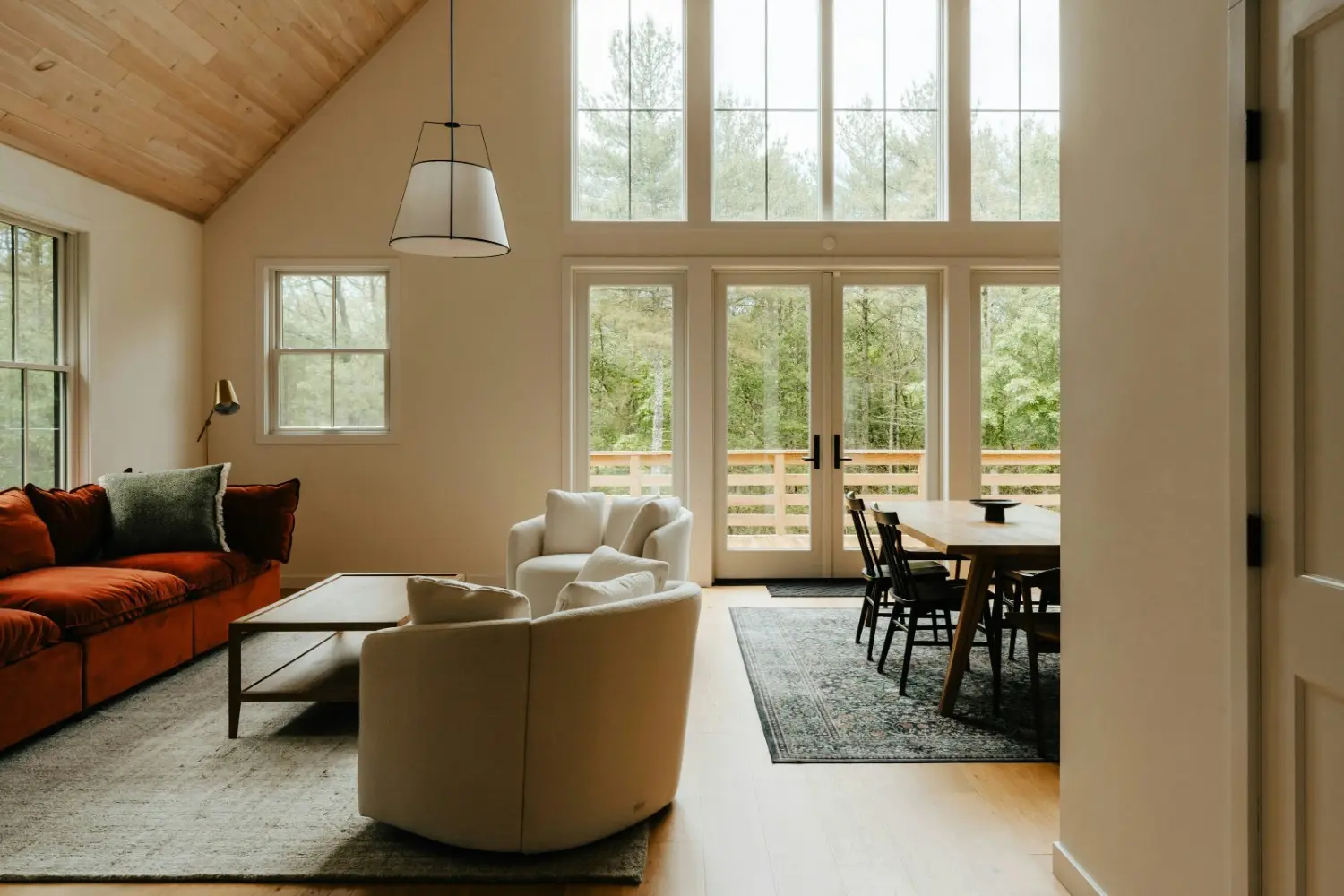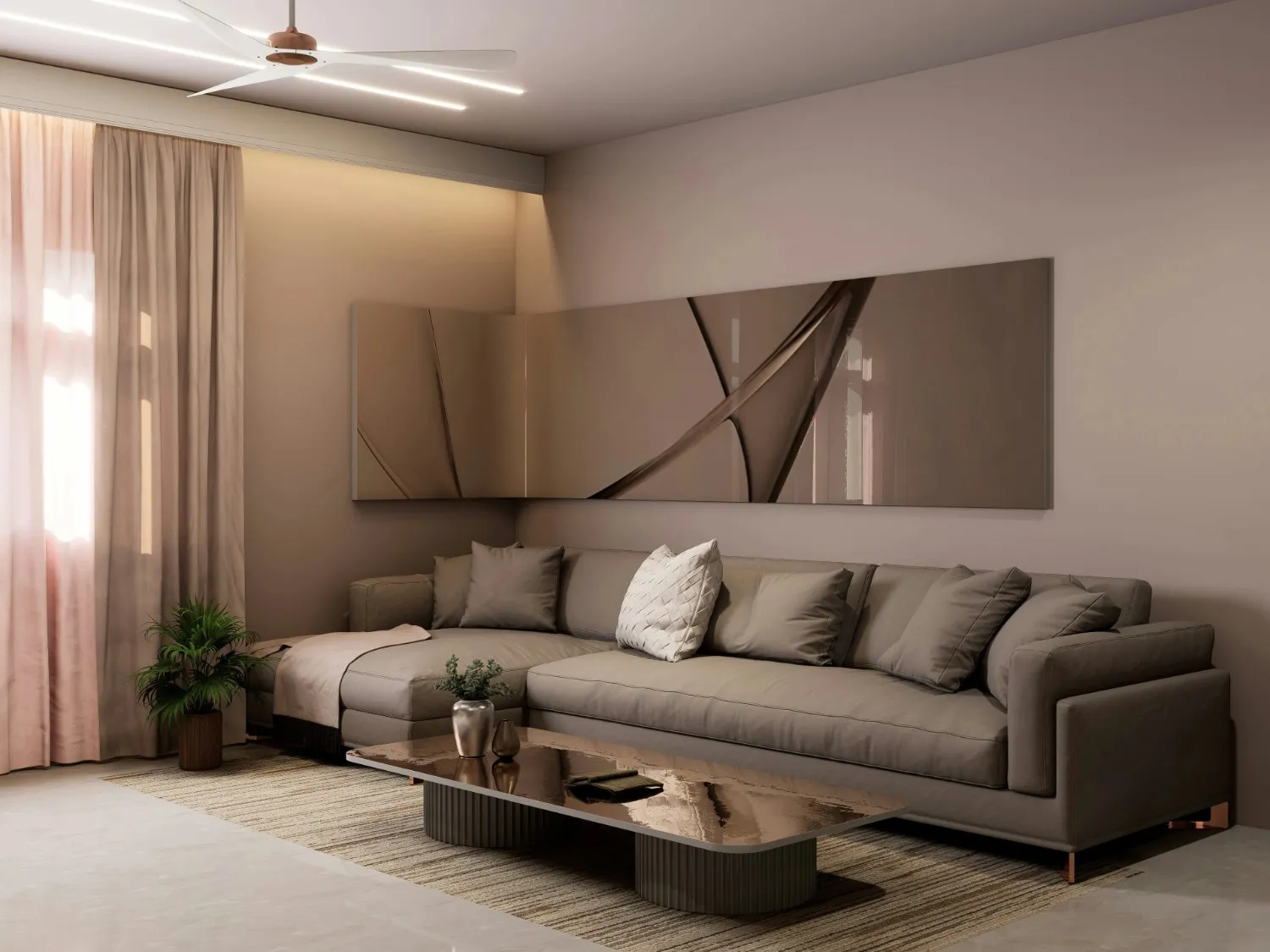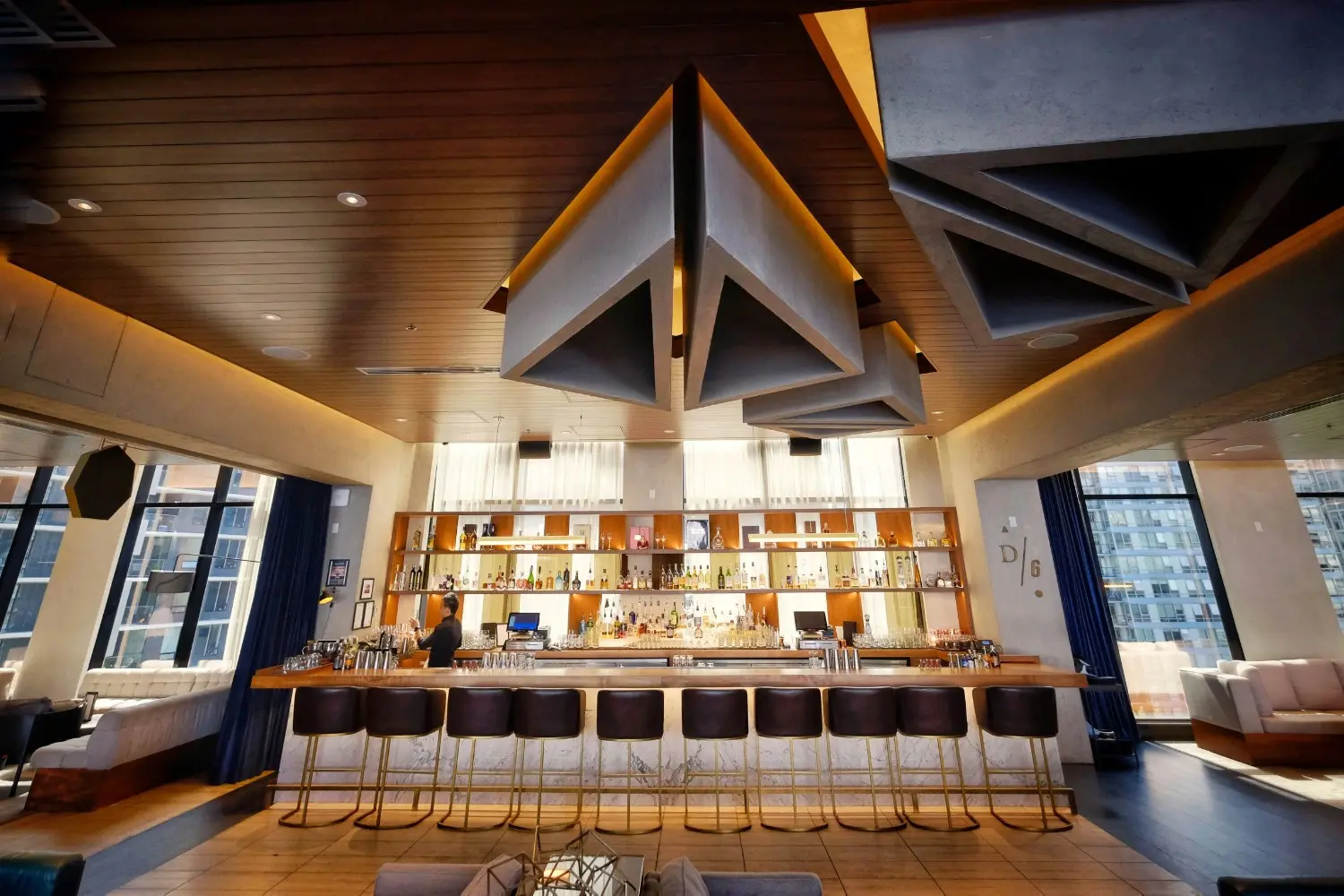The way offices look and feel has become a reflection of how people work. Office interior decoration is no longer just about appearances. It defines how employees think, collaborate, and connect. In this guide, Ark & Mason explores how design choices in modern offices are setting new standards for productivity, creativity, and well-being in 2025.
Highlights
- Flexible layouts and biophilic design dominate office interior decoration in 2025.
- Smart technology and acoustic zoning balance collaboration with focus.
- Decoration choices now shape company culture as much as brand storytelling.
Rethinking Office Spaces for Flexibility
Modern offices are moving away from rigid layouts and toward adaptable environments. Modular furniture and movable partitions make it easy to shift from solo work to team sessions in minutes. Hot desking, once reserved for co-working hubs, is now standard across many corporate spaces.
According to McKinsey, hybrid and flexible formats have stayed largely consistent since 2022 despite policy shifts. One recent update shows that mostly in-person workers now make up 68%, while hybrid models still play a central role. This shows the ongoing need for reconfigurable spaces that make the commute worthwhile.
Hybrid work has made flexibility a must. Teams no longer sit in fixed spots but select workpoints suited to their daily needs, quiet areas for focus, collaborative lounges for brainstorming, and social corners for informal chats. According to Gensler’s 2024 Global Workplace Research, employees say they need to spend about 63% of their week in the office to be most productive. However, most spend less time there because the space mix often fails to match their needs, a gap that thoughtful design and variety can close.
Some workplaces are experimenting with automation. Robotic partitions and responsive lighting systems now adapt to occupancy, creating spontaneous zones for meetings or private calls. It’s design that moves with purpose, functional, fluid, and human-centered.
Bringing the Outdoors Inside with Biophilic Design
Nature has made its way into the workplace. Designers now prioritize natural light, living walls, and potted greenery to bring calm and clarity into high-pressure environments. Studies show that exposure to natural elements can lower stress and spark creativity, which explains the growing popularity of biophilic design.
A large cross-country study of 7,600 office workers found that spaces with biophilic features lead to 6% higher productivity, 15% greater creativity, and a 15% increase in overall well-being. These small improvements can add up significantly over time.
Reclaimed wood, bamboo, and other sustainable materials are also gaining attention. They give interiors texture and warmth while supporting environmental goals. The combination of green partitions, water features, and open layouts creates a sense of freshness that traditional offices lack. Globally, WELL-certified spaces now cover more than 6 billion square feet, and LEED projects have saved over 120 million metric tons of CO2 throughout their lifetimes. These results show that healthier materials and systems are becoming the new industry standard.
For Ark & Mason, biophilic design is more than a visual choice, it’s a wellness strategy built into every interior design service. Natural light, breathable spaces, and organic materials form the foundation of a healthy and motivating workplace.
See more: 10 Best IT Office Interior Design Ideas
Top Office Interior Decoration Trends Defining Modern Workspaces
Office spaces are transforming faster than ever, blending design, technology, and human comfort into one cohesive environment. The following office interior decoration trends show how modern workspaces are evolving into places that inspire focus, collaboration, and creativity.
1. Flexible and Modular Workpoints
Activity-based design has redefined the office floor plan. Rather than assigning desks, companies now design zones that adjust to changing tasks. Furniture innovations, like hexagonal desks, café-style seating, and rolling storage units, turn ordinary layouts into multifunctional hubs. According to Gensler’s research, 83% of employees say they would spend more time in the office if the space offered the right mix of experiences, showing how valuable adaptable design has become.
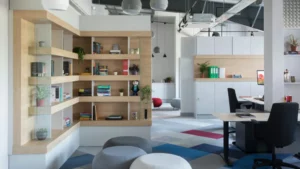
Ark & Mason’s CoBees Office project is a strong example. Their team combined open meeting spaces with tucked-away nooks, proving that flexibility doesn’t have to compromise privacy. This adaptive approach makes every square foot count.
2. Biophilic and Sustainable Materials
Offices today aim to balance style and sustainability. Green partitions, reclaimed wood, and recycled metals are now standard materials in many design plans. Some projects even use water features or vertical gardens as natural sound barriers.
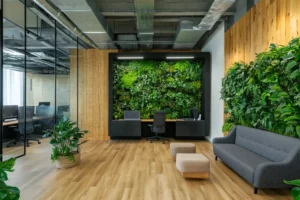
Eco-conscious finishes aren’t just good for the planet, they also improve indoor air quality. Certification systems like LEED and WELL are becoming benchmarks, pushing designers to make better choices. Ark & Mason often integrates these principles during concept development and construction documentation to align design goals with environmental performance.
3. Wellness and Human-Centered Design
Workplace wellness is not a trend, it’s a design standard. Adjustable desks, ergonomic chairs, and soundproof wellness rooms support employee comfort and focus. More offices now include quiet pods, sensory-friendly areas, and gender-neutral facilities to accommodate diverse needs.

This human-first approach reflects how office design directly affects physical and mental health. Ark & Mason’s work on LNG Studios demonstrates how well-planned layouts and ergonomic detailing can create a space that’s both practical and inspiring.
4. Resimercial Aesthetics
A blend of residential comfort and commercial function defines the modern office look. Soft furnishings, rugs, and ambient lighting add warmth, creating spaces where people actually want to spend time. Lounge corners mimic living rooms, helping staff relax and collaborate naturally.
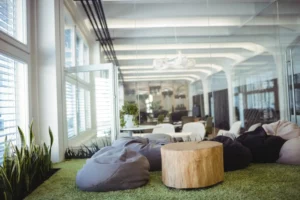
The goal is to make offices feel personal yet professional. This ‘resimercial’ touch encourages connection and creativity, something sterile environments often lack.
5. Smart & Tech-Driven Interiors
Technology has shifted from convenience to necessity. Smart systems now control lighting, climate, and security automatically. IoT sensors track occupancy to save energy and manage comfort. Meeting rooms are upgraded with interactive screens, wireless sharing, and high-quality video conferencing setups.
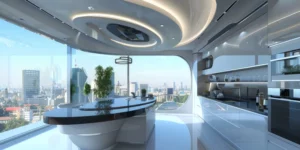
AI-enabled furniture and environmental monitoring tools are rising, too. These systems adjust in real-time to user preferences, cooler lighting for focus, warmer tones for relaxation. Ark & Mason often pairs these features with our 3D rendering services to help clients visualize and fine-tune their smart interiors before construction begins.
6. Acoustic Zoning for Focus
Open-plan offices have their benefits, but noise remains a top complaint. Acoustic zoning addresses this by blending sound-absorbing materials and strategic layouts. Ceiling baffles, wall panels, and carpeting soften echoes while maintaining openness.

Soundproof pods are becoming standard for calls or solo work. In Ark & Mason’s commercial projects, layered acoustic systems are built into the design early, avoiding the need for expensive fixes later. Our construction management services team ensures precision during installation to maintain both style and performance.
7. Social and Community Hubs
Offices are not only for work, they’re social ecosystems. Café-style corners, kitchenettes, and informal lounges foster spontaneous conversations that often spark ideas. Designers now plan ‘third spaces’, zones that fall between formal and casual, to encourage authentic connection.
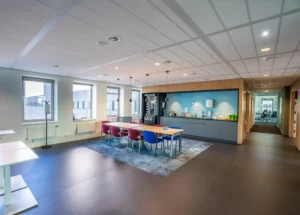
These community-focused areas are especially important in hybrid workplaces. They help remote and in-office staff reconnect, building culture through shared moments.
8. Brand Expression in Decoration
Brand storytelling has moved from websites to walls. Offices now reflect company identity through color palettes, murals, and custom art. Materials, patterns, and local craftsmanship bring personality to the space while reinforcing values.
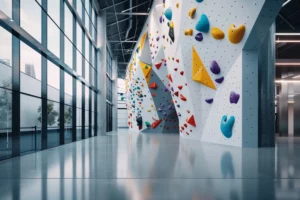
Ark & Mason’s recent work for Motus Engineering illustrates this idea well. Clean lines, wood textures, and minimalist details mirror the client’s precision-driven engineering culture. Through thoughtful design development, the result feels authentic and aligned.
Partner with Ark & Mason for Office Interior Decoration
Ark & Mason isn’t just a design studio. We’re a Vancouver-based team that unites creativity and construction under one roof. Our process combines concept creation, 3D visualization, permit handling, and construction management into one smooth journey of commercial interior design.
From boutique offices to large commercial builds, Ark & Mason turns ideas into reality through structured collaboration. Projects like CoBees Office and LNG Studios highlight our ability to craft environments that balance design appeal with real-world function.
Clients repeatedly mention their fairness in pricing, clarity in communication, and punctual delivery. Every detail, materials, layouts, lighting, is planned to reflect a company’s brand while improving how teams work.
Our end-to-end service covers everything: permit application, construction tender, project scheduling, and full construction budgeting. This design-build model keeps the process consistent, organized, and free of unnecessary delays.
Whether designing a 900-square-foot office or managing a multi-level workspace renovation, our approach stays the same, collaborative, transparent, and deeply personal. We create commercial interiors that don’t just meet expectations; we reshape how people experience work.
FAQs: Office Interior Decoration
1. What is the most important office interior decoration trend for 2025?
Flexibility leads 2025 trends. Adaptable layouts and movable furniture support hybrid work while maintaining visual harmony.
2. How can small offices adopt flexible decoration strategies?
Start with modular furniture, foldable partitions, and mobile storage. These elements expand usability without needing more space.
3. What are cost-effective ways to integrate biophilic design?
Use potted plants, reclaimed wood, or natural color schemes. Small changes in materials and lighting can make a big difference.
4. How does office decoration influence employee wellness and productivity?
A well-designed space promotes better posture, mental clarity, and team engagement. Design directly shapes how people feel and perform.
5. What’s the role of technology in shaping office decoration today?
Smart systems, from lighting controls to occupancy sensors, make spaces responsive and energy-efficient. They also support hybrid teamwork and comfort.
See more: 10 Best Bar Interior Designers in Canada Creating Modern Nightlife Spaces
Conclusion
The future of office interior decoration is less about aesthetics and more about experience. It’s about creating workplaces that adapt, inspire, and tell a story. Through thoughtful design and smart construction, Ark & Mason continues to redefine what modern offices can be. To plan your next workspace transformation, contact us today.

